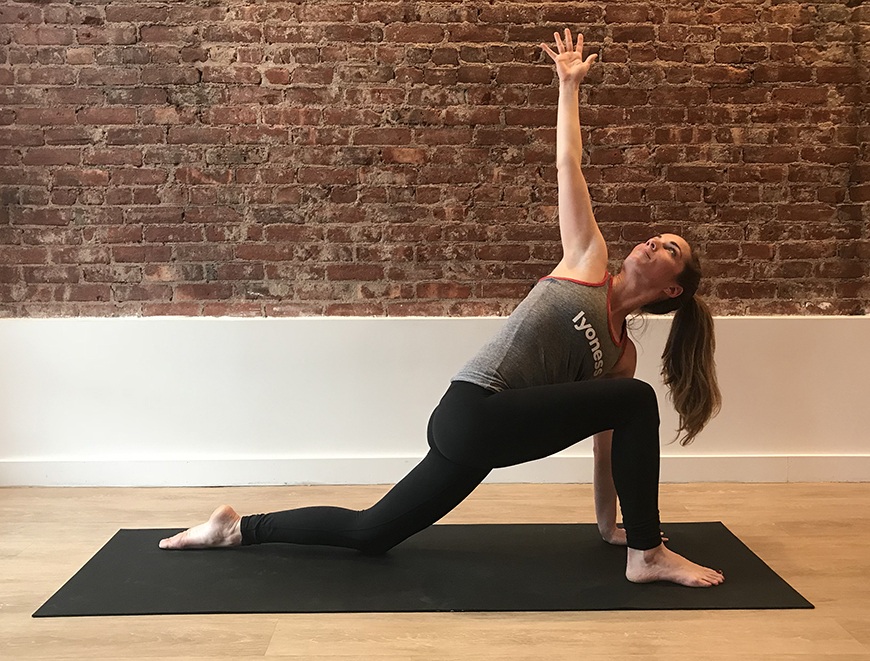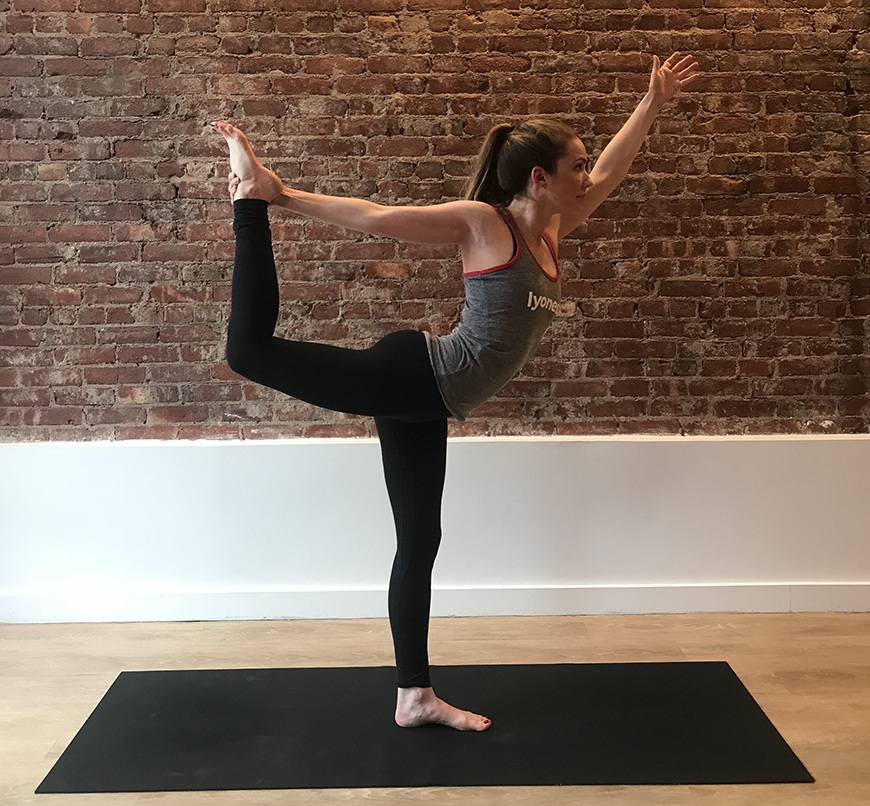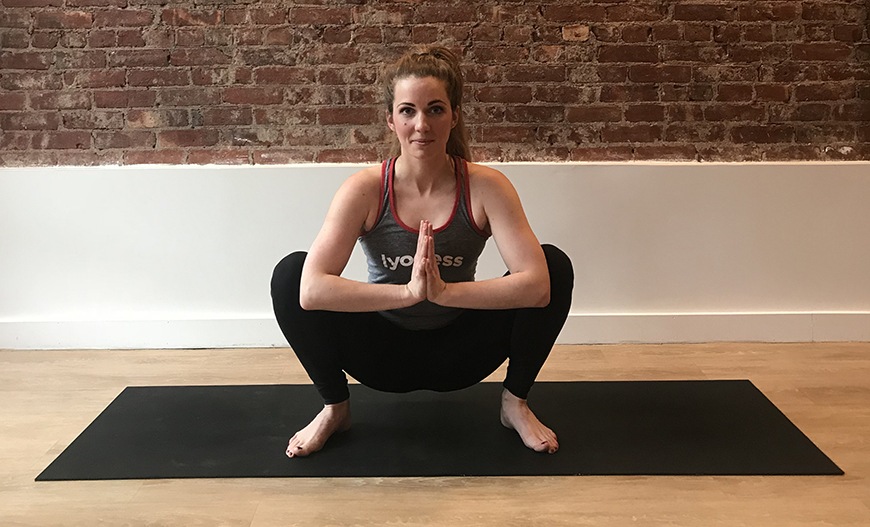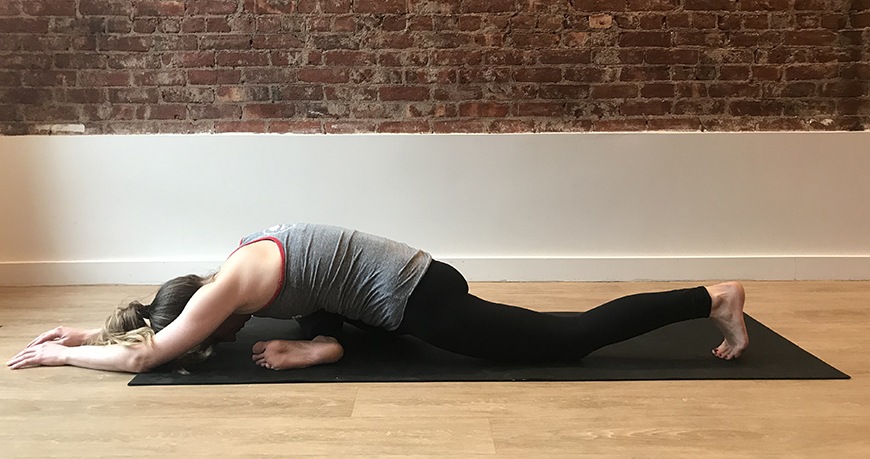Whether you run a 5K a day with your girlfriends or you're in the midst of marathon training, you probably feel it: tight hips, achy hamstrings, and rock-solid quads. And while running comes with loads of mental and physical benefits (hello, totally legit runner's high!), strapping on the sneaks and pounding the pavement (or treadmill) means your body will require a little off-road TLC. You need to keep your *whole* self happy and healthy, in the end.
Enter yoga. Now, if you already have a solid practice under your belt, keep it up, and if you're a yoga novice, fear not: These poses are accessible, adaptable, modifiable, and absolutely doable. Plus, you need them. "Running, no matter the level and distance, can take a toll on the body," says Austin Kapetanakis, a 200-hour certified Baptiste yoga instructor at New York City-based Lyons Den Power Yoga and a two-time marathoner. "Over time, our body and muscles get tight and broken down from running. A yoga practice can speed up recovery and help runners stay loose and healthy by strengthening and elongating the major muscles."
A yoga practice can speed up recovery and help runners stay loose and healthy over a long period of time by strengthening and elongating the major muscles.
In addition to just getting your stretch on, these poses will help increase flexibility, mobility, and pliability—and, bonus, will improve your overall body and core strength.
Convinced? Cool. Get started with these 6 yoga poses every runner should try.

1. Low lunge with rotation
Why you need it: "Low lunge is a great pose to do before or after a run because it stretches and opens the hips, hip flexors, groin area, quadriceps, hamstrings, and calves," says Kapetanakis. The more you run, the more your body tightens and stiffens up. Low lunge can help dynamically strengthen and lengthen the major muscles you use when you're running, and helps them recover after a long run.
How to do it: From standing, step your right foot forward into a lunge position, with the right thigh working toward being parallel to the floor at a 90-degree angle. Make sure your right knee is stacked directly over your ankle, and bring your left knee down to the floor, placing the top of the left foot on the ground. From there, actively reach your hands up towards the sky to deepen the pose and lengthen the spine and torso. If you want to go the *extra* distance, drop your left hand in front of you in line with your left thigh, parallel to your right foot, and reach your right hand up to the sky for an additional twist through the hips. Hold on one side for 5 to 10 breaths, and then switch sides.

2. Dancer
Why you need it: "Dancer is a dynamic balancing pose that strengthens and tones the leg muscles, and provides a great full-body stretch, especially in the hips, quadriceps, and upper body," Kapetanakis says. "It improves your balance, strengthens the muscles and joints in your legs, and helps stretch and open up your entire body." Holding all of your weight on one leg greatly increases your overall balance and body awareness—and you'll feel like a super woman once you nail it.

{{post.sponsorText}}
How to do it: Stand tall with both feet together. From there, start to bend the right knee while bringing the right heel toward your butt. Grab for your right inner ankle with your right hand and begin to lift your right foot toward the ceiling. At the same time, reach your left arm forward and up toward the ceiling. As you balance on your left foot, actively press down into the floor with your entire foot as you start to open your chest and press your lifted leg back and up. Keep the torso upright and actively press the tailbone down toward the floor. Hold on one side for 5 to 10 breaths, and then switch sides.

3. Deep squat pose (AKA garland pose or malasana)
Why you need it: "Sitting in this deepening pose is a fantastic way to open up and stretch all of the muscles in your lower body, and helps increase overall mobility," says Kapetanakis. "It even helps with sitting and getting up from the ground." So simple, yet so powerful.
How to do it: From standing, separate your feet about shoulder-width distance apart (wider if you're not super bendy). Begin to drop your hips down into a squat. As you press your hips back and down toward the floor, send your knees out in line with your toes, making sure they don’t cave in toward the body. Actively press the knees outward and sit in the deep opening position of the squat. Bring your palms to touch at your chest, and actively press your elbows into your knees. Your knees may not come all the way down, and that's fine as long as your heels come up slightly from the ground. Stay in this pose for 15 to 20 breaths, allowing the lower body to fully open up.

4. Half pigeon
Why you need it: "Half pigeon is a hip opener that stretches the hips and piriformis muscle, which gets very tight in runners," Kapetanakis says. (The piriformis is the small muscle in your butt that helps rotate your hip, leg, and foot.)
How to do it: Come onto your hands and knees on the floor. Draw the right knee as close as possible to the right wrist, then work on bringing the right foot toward the left hand. Try to create as much of a 90-degree angle as you can between the right shin and the right thigh. From there, stretch the left leg and left foot straight back, keeping the toes tucked. Relax the upper body forward and over the right shin, stretching both arms forward and pressing both hips toward the floor. Try and stay as still as possible and breathe deeply for 15 to 20 seconds, then switch sides.

5. Seated forward fold
Why you need it: "Forward folds lengthen our whole posterior chain—the backside of the body—and loosens up our hamstrings, glutes, and lower back, which get super tight and strained from running," says Kapetanakis. "This pose is less intense on the body and can be held for a long period of time, allowing for a musculature release that will leave you feeling refreshed, balanced, and restored."
How to do it: Sit on the floor with both legs extended forward, legs and ankles touching. Press the top of your thighs down to the floor and flex both feet back toward your face. Take a deep breath in and reach both arms toward the sky. As you reach up, lengthen the spine and torso as much as you can, then, on an exhale, hinge from the hips and reach both hands toward your feet, grabbing for your feet, ankles, or shins. Try bending the knees first and slowly start to straighten your legs. As you hold this pose, slowly lengthen more and more toward the floor, bringing your chest closer to your thighs. Hold for 15 to 20 deep breaths.

6. Legs up the wall
Why you need it: "Inversions are a great way to reverse blood flow in our body and give our legs a rest from carrying us around all day," Kapetanakis says. "This supported inversion helps drain excess fluid from our legs, allowing them to recover after a run, and reduces swelling in the lower body. The sooner you can do this after a run, the better."
How to do it: Sit sideways next to a wall so that your left leg, hip, and shoulder are touching it. Swing your legs up on the wall and recline onto your back. Adjust as needed to bring your butt as close to the wall as possible, which will allow you to be fully supported. Reach both arms alongside the body, actively flexing the feet toward your face. Breathe deeply for 3 to 5 minutes.
There's an asana for every ache and ailment. Try these poses to detoxify your body, these for better sleep, these to ease anxiety, and these to make you happier.
Loading More Posts...